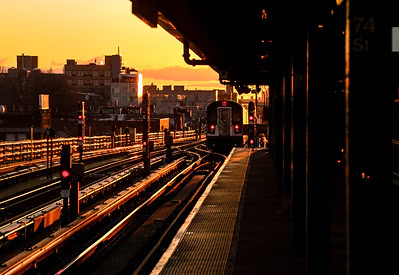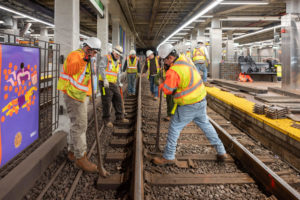Metro’s proposed $8.8-billion budget for FY 23 focuses on improving the customer experience
Written by L.A. Metro, L.A. Metro Communications
Metro’s proposed $8.8-billion budget for the next fiscal year will be considered by the agency’s Board of Directors at their meeting on Thursday, May 26, at 10 a.m.
Click here to watch a livestream of the meeting; the webstream will be archived if you’d like to view at a later date.
Click here to view the FY23 Proposed Budget; here is the staff report for Thursday’s meeting. Since the budget is a big document with a ton of detail, we wanted to offer some broad highlights:
•The proposed budget is balanced. Thanks to major one-time infrastructure investments from the federal government, we are able to stay on track with our capital projects and support ongoing customer service improvements, despite the drop in revenue on our system during the pandemic.
•This budget puts a clear focus on improving the customer experience. We want to make riders feel safe and comfortable, and we want our service to be convenient to your travel needs. This includes improving and expanding cleaning protocols and responding to customer requests to replace all fabric seats by the end of the next fiscal year.
•Safety is Metro’s top priority. We are doing more to address public safety and homelessness on our system, and to do so with compassion. We’re boosting funding for public safety by 12.5 percent over the current year and putting that money into our Reimagining Public Safety initiative. The effort will: expand our transit ambassador program; grow our homeless and mental health outreach activities; continue our work with law enforcement agencies that help patrol our system, and; add unarmed security officers to the system.
•Our budget is focused on ensuring that Metro’s core work in planning, transit operations and construction activities is seen through an equity lens. What does this mean? In short, we’re striving to ensure our customers and all stakeholders are able to help shape our projects, services and programs.
•As part of our equity efforts, Metro changed the way it does its budgeting this year. We asked every department to start from scratch — as in zero funds — and to justify the funds they were seeking to ensure that as an organization we are offering equitable access to our programs and services. We think that resulted in a healthier budget with funding for programs that work and directly benefit our customers and the region.
•The budget puts two critical new lines into service. The K Line (also known as the Crenshaw/LAX Line) will offer light rail service in the Crenshaw Corridor and eventually connect to LAX — a long-sought goal in our region. The Regional Connector is tying together the A (Blue), E (Expo) and L (Gold) Lines for quicker rail trips to and through downtown Los Angeles with fewer transfers. As part of the Connector, we’re also opening three new underground stations in downtown that will provide easy access to Little Tokyo, the Arts District, the Civic Center, the Historic Broadway Corridor and Bunker Hill, including the many cultural offerings along Grand Avenue.
•The proposed budget includes $2.3 billion for transit expansion. In addition to the two rail projects opening in FY 23, construction continues on all three sections of the Purple (D Line) Extension of the subway to Westwood, the L Line Extension to Pomona and the Airport Metro Connector — the future transfer point between Metro Rail and the LAX Automated People Mover that will take riders to the airport terminals.
•We’re continuing to fund and expand new programs that are working well. Our GoPass pilot program is already providing free transit rides to more than 100,000 K-12 and community college students in L.A. County — and students have taken more than 3 million rides (and counting) with their GoPass. We also revamped our Low Income Fare is Easy (LIFE) program in the past year, offered even more steeply discounted fares and made it much easier for qualified people to sign up. Since last September, more than 51,000 riders have done so and overall we know have almost 141,000 riders who have signed up for LIFE. We’ll continue our push to get more eligible riders in LIFE in FY 23 as a way to help riders who depend on us the most. Metro connects many of these riders to jobs that serve as the foundation of our local economy.
•This isn’t just a budget for Metro — the proposed budget includes $1.9 billion in funding for other transportation agencies in L.A. County and another $273 million for regional rail — which includes Metrolink, the commuter rail agency that connects Los Angeles, Orange, Riverside, San Bernardino and Ventura counties.
•The budget also includes $634 million for our highways program that continues to work to ease chokepoints that worsen traffic congestion.
•The ongoing COVID-19 pandemic has been tough. The more than $1 billion provided to Metro in federal relief funds from the American Recovery Plan Act has been critical to keeping Metro stable and enabling us to avoid layoffs or drastic cuts to services.
•Like other transit agencies across the world, we’re working to rebuild ridership and adjust to post-pandemic life and changing commuting habits (lots more people still working at home, for example) and realities. Yet, Metro has been able to continue to make progress on a number of fronts as we work to make getting around easier for everyone in L.A. County.
Our budget for FY 23, like all budgets, is a one-year snapshot – it’s the financial roadmap that seeks to balance investments in the current and future mobility needs of L.A. County and surrounding region. Our Service improvements, capacity enhancements, and region-wide partnerships all strive to reduce congestion and pollution, improve mobility and continue to make Los Angeles County a better place to live, work, and play.
For brief news updates and commentary, please follow me on Twitter @davidclesterRTS





